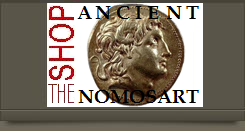
about ancient nomos
Ancient Nomos Art is a museum of galleries exhibiting ancient coins and ancient mint maps. The coin gallery displays the diverse art and history of hand-crafted ancient Greek, Roman, Byzantine, Persian and Medieval coinage. The ancient mints mapping gallery features Greek, Roman, Byzantine, Asia Minor and Medieval mint city regions and territories. Visitor's are welcome to explore, study and enjoy Ancient Nomos Art.

Greek, Aeolis – 165 BC
Aeolis, Kyme
From Ancient Galleries

Obverse: Head of the Amazon Kyme facing right, wearing her tainia hairband.
Reverse: Horse standing right with raised leg, cup below; all within laurel wreath.
LEGEND SYMBOLS
Obv. Head of the Amazon Kyme facing right and wearing a tainia with hair in a bun. Rev. Horse prancing or rearing up facing right; one-handled oinochoe cup below raised left foreleg, magistrate ΜΗΤΡΟΦΑΝΗΣ below exergue line, ΚΥΜΑΙΩΝ to right; all within a laurel wreath.
The above ancient Kyme tetradrachm, or stephanophorus (wreath bearer coin) in Greek, is considered one of the most artistic of the Hellenistic issues and perhaps one of the finest die engravings of the late Classical Greek period. The city of Kyme, located along the Ionian Sea in the Anatolia region of ancient Greece, was the largest and most important of the twelve cities of Aeolis. These large, regal and impressive coins were only issued for a brief period of time following a long struggle for independence, culminating in the collapse of the Seleukid Empire in 189 BC. Many of the twelve Aeolian cities celebrated their Seleukid liberation by striking their own coinage on a new design utilizing a broad silver flan and a slightly lower Attic standard weight. Many numismatists have suggested these new issues were perhaps influenced by the contemporary “new style” coinage of Athens (see Athens “new style” tetradrachm). While appearing similar in type, these new issues differ in significant ways. The coins obverse depicts the bust of a female head facing right, with hair in bun and wearing a simple head band. She is thought by many to represent the goddess Amazon of Kyme. The entire series has been dated to a period between 151-145 BC (Meadows & Houghton). The female head is seen wearing a simple tainia (hair band) and no apparent jewelry. Some question this simple depiction of the female bust as not being a goddess portrait because of her apparent lack of God-like embellishments, i.e. jewels and field attributes such as grapes, leaves, griffins or palmettes, as typically found on other contemporary issues. Needless to say, she in all likely hood represents the symbolic patron deity to the city of Kyme. The coins reverse depicts a bridled horse standing right, with head gesturing upward and left foreleg raised, perhaps preparing to rear up onto its hind legs. Directly below its raised left foreleg is a medium sized oinochoe (amphora) vessel with a single handle on the right. The Kyme city ethnic legend KYMAIΩN in Greek is seen engraved vertically to the right. The issuing authorities name or magistrate legend METROΦANHZ in Greek is noted directly below the exergue line or ground plane. Numismatic die studies have verified that a total of twelve different magistrate names are known to have signed this brief tetradrachm series. The issues engraved with magistrate Metrophane have been researched and dated by Mattingly to the year 146-145 BC. In addition to these reverse symbols, the all-important large circular laurel wreath, tied loosely at its base, appears to form a distinctive boundary that encompasses the horse, vessel and legends. As mentioned above, the common name for Kyme coinage was “wreath bearer,” as noted by the ancient Delos inventory texts referring to payments with “stephanophoroi” coinage. This coin’s bold portraiture, gallant horse and vessel are recurring symbols on many of the Kyme’s earliest ancient coin issues and are likely important testamentary aspects of the city’s culture, economic success and agricultural industry during this brief 2nd century period of Aeolian independence.
DOCUMENTATION
Value: Tetradrachm (Stephanophorus). Metal: AR Silver. Weight: 16.69 grams. Mint: Kyme. Date: 146-145 BC.
Attribution: Oakley dies 9/b; SNG Copenhagen 104; SNG Von Aulock; ANS MN 27, 1-12; BMC Aeolis, page 111, 74.
Legend, Documentation and Attribution
